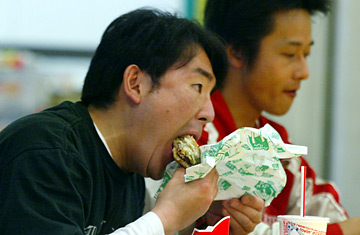
A man eats a humburger at a fast-food restaurant in Narita, northeast of Tokyo.
Etsuko Shinobu has 33 years of experience as a proper Japanese housewife, shopping twice a day for fresh groceries and cooking traditional meals for her husband and two children. I have a refrigerator full of half-empty Coke bottles and shop twice a month, usually for more Coke. Shinobu-san has much to teach me in the art of Japanese homemaking, which is why I've come to her tidy home in northwest Tokyo, where she's begun offering cooking lessons for curious tourists.
As commuter trains rumble outside the window of Shinobu's crowded kitchen, we prepare tuna sushi cake, tofu, a carrot and radish soup and a vinaigrette salad. As we sit on the tatami mat, sipping plum wine and eating from each bowl in turn, the kimono-clad 60-year-old explains what makes a proper Japanese meal. "It's about the balance of nutrition," she says. "We need to have fish, vegetables, soup at every meal — and of course rice." Shinobu's meal is scrumptious, but when I compliment her, she demurs. "I'm just an ordinary housewife."
Thirty years ago, perhaps, but today Shinobu is anything but ordinary. The proper Japanese meal, prepared by the mother and eaten on the tatami mat by the entire family, is increasingly rare, thanks to long hours at work and at school, and social changes that have resulted in more women working out of the home and delaying marriage. With limited time and inclination for balanced home cooking, many people simply grab prepackaged meals at ubiquitous convenience stores, or down fattening fast food. That has nutritionists and public officials fearing that knowledge of traditional Japanese cooking — and eating —is being lost. "I think we're in a crisis situation now," says Nobuo Harada, a food expert at Kokushikan University outside Tokyo. "We're in the process of losing the food culture of Japan."
Traditionally, Japanese families would eat meals like the one prepared by Shinobu every day: low in fat with lots of seafood, it is a cuisine that has helped the country to world-record levels of life expectancy. But Nobuko Iwamura says the wholesome Japanese diet is, today, mostly a myth, and she has the photo evidence to prove it. Since 1998, Iwamura has conducted in-depth surveys on what the Japanese are actually eating, asking thousands of Tokyo-area parents to photograph the meals they serve their families over the course of a week. The results are surprising to anyone who believes Japan is a paragon of healthy eating. Flipping through a thick binder, she shows photos of dinner tables topped with McDonald's Happy Meals, skimpy take-out rice balls, a microwavable hamburger steak — the same kind of fast food on which a harried Western family might survive. "The gap between what we think the Japanese eat and what they really eat is enormous," says Iwamura, a lead marketer for the Tokyo advertising agency Asatsu-DK. "I can't imagine how bad Japanese health really is. I'm surprised these families are still alive."
It's too simple to blame the decline of the Japanese diet on the arrival of Western fast-food chains over the past several decades. It first took a hit at the end of World War II, when the nation was starving, and the U.S. occupation sought to fatten up a generation of underweight children through mandatory school lunch programs that pushed calorie and fat-rich Western foods such as milk, pork and bread at the expense of the Japanese diet. Millions of Japanese schoolchildren grew up eating like their American counterparts, while the government told their parents that traditional Japanese food was nutritionally deficient. Between 1960 and 1996, rice consumption dropped by more than half, while intake of dairy products has increased 20-fold compared with the prewar years. "Children grew up not even knowing what a traditional Japanese meal looks like," says Ayako Ehara, a professor of home economics at Tokyo Kasei Gakuin University. "All these changes made it impossible for Japanese food culture to be passed from one generation to another."
Punishing office and school schedules make a home-cooked meal a fantasy for most Japanese families during the week. The pre-cooked convenience store food that usually substitutes at home is a nutritionally inferior substitute, and those dinners on the run promote what Iwamura calls "selfish eating," with each family member consuming alone, rather than together at the dining table. With mothers increasingly working outside the home — and with family size shrinking, as young people hold off on marriage — there's even less reason to eat a healthy Japanese meal at home. "People aren't interested in eating well," says Iwamura. "They prefer to eat what they like."
Now, in an effort to preserve the country's culinary culture, schools have begun promoting "food education" — teaching students Japanese eating habits. Children take time out of math and science to visit a farmer harvesting rice, or learn to prepare buckwheat soba noodles — a favorite Japanese dish —from scratch. But critics like Iwamura and Ehara say the classes have more to do with promoting Japan's inefficient and politically protected farming sector than cooking or eating. The reality is that as long as increasing numbers of Japanese have to be at work or school until late at night, there'll be no one to prepare — or to enjoy — balanced, traditional meals at home.
Even Shinobu's family seldom eats at home on weeknights. As she wraps the leftovers from lunch, Shinobu says that her own grown daughter, a travel agent in central Tokyo, has been too busy to learn how to cook. "But she chose a husband who knows how to cook, so she's lucky!" Shinobu adds. Luckier than many in Japan.
— With reporting by Toko Sekiguchi/Tokyo
